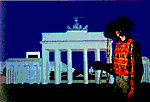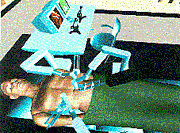2.4. Virtual Reality: a Postmodern Concept of Reality
From the viewpoint of human evolution, VR resembles the invention of fire.- Michael Heim

 The term 'virtual reality' (VR) was coined by the Techno-DJ, computer-artist
and hardware-developer Jaron Lanier in 1986. 'Virtual' becomes
in computerjargon often used for something near substitutes e.g.
virtual memory. VR has been recently defined as "a real or simulated
environment in which the perceiver experiences telepresence."
(Steuer quoted by Featherstone; Burrows 1995: 5). Just as the
term cyberspace is considered as unscientific it is the same with
the term Virtual Reality. Scientists therefore often try to substitute
'virtual reality' with terms like 'virtual environment', 'virtual
worlds' or 'possible worlds'. But there are good reasons to stay
with VR, as it offers some analytical qualities. Virtual reality
technology aims to surround the human body with an artificial
sensorium of sight, sound and touch and therefore tries to simulate
or substitute reality: "When a user identifies with a world, it
then becomes an existential reality - even if only a virtual reality."
(Heim 1995: 67) "In VR, the images are the realities. We interact
with virtual entities, and we become an entity ourselves in the
virtual environment. As in the medieval theory of transubstantiation,
the symbol becomes the reality." (Heim 1995: 70)
The term 'virtual reality' (VR) was coined by the Techno-DJ, computer-artist
and hardware-developer Jaron Lanier in 1986. 'Virtual' becomes
in computerjargon often used for something near substitutes e.g.
virtual memory. VR has been recently defined as "a real or simulated
environment in which the perceiver experiences telepresence."
(Steuer quoted by Featherstone; Burrows 1995: 5). Just as the
term cyberspace is considered as unscientific it is the same with
the term Virtual Reality. Scientists therefore often try to substitute
'virtual reality' with terms like 'virtual environment', 'virtual
worlds' or 'possible worlds'. But there are good reasons to stay
with VR, as it offers some analytical qualities. Virtual reality
technology aims to surround the human body with an artificial
sensorium of sight, sound and touch and therefore tries to simulate
or substitute reality: "When a user identifies with a world, it
then becomes an existential reality - even if only a virtual reality."
(Heim 1995: 67) "In VR, the images are the realities. We interact
with virtual entities, and we become an entity ourselves in the
virtual environment. As in the medieval theory of transubstantiation,
the symbol becomes the reality." (Heim 1995: 70)

 The attainable level of realism is improving rapidly with the
rapid technological development in this field. It is supposed
to be one of the new killer-applications for highend computers
and so the Cyberian paradigm finds its way to our unsuspecting
minds through new kinds of arts and entertainment. Although VR
wants to make believe that it is real, this region is very different
from the reality we have grown to know and love. "We are on the
edge of moving into a preconfigured world which bears little relation
to our previous speculations." (Featherstone; Burrows 1995: 2)
The attainable level of realism is improving rapidly with the
rapid technological development in this field. It is supposed
to be one of the new killer-applications for highend computers
and so the Cyberian paradigm finds its way to our unsuspecting
minds through new kinds of arts and entertainment. Although VR
wants to make believe that it is real, this region is very different
from the reality we have grown to know and love. "We are on the
edge of moving into a preconfigured world which bears little relation
to our previous speculations." (Featherstone; Burrows 1995: 2)
VR wants to make believe that it is reality in simulating reality, but it is not only simulating reality but even determining how reality can or has to be. The whole debate/discourse about VR can be seen as a debate concerned with the question what happens to reality in an electronic age. Nicholas Negroponte, the director of the Media-Lab at the MIT (Massachusetts Institute of Technology) describes 'virtual reality' as an oxymoron (two words which contradict each other) on its best way to become a pleonasm (two words that express the same).
 "If the componentwords of virtual reality are seen as equal halves,
thinking about VR as a redundant concept makes more sense. VR
can make the artificial as realistic as, and even more realistic
than, the real. For example, flight simulation, the most sophisticated
and longest-standing application of VR, is more realistic than
flying a real plane. Newly trained but fully able pilots take
the controls of a completely loaded passenger plane for their
first flight in a 'real' 747, because they have learned more in
the simulator than they could have learned in the actual plane."(Negroponte
1995: 116f.)
"If the componentwords of virtual reality are seen as equal halves,
thinking about VR as a redundant concept makes more sense. VR
can make the artificial as realistic as, and even more realistic
than, the real. For example, flight simulation, the most sophisticated
and longest-standing application of VR, is more realistic than
flying a real plane. Newly trained but fully able pilots take
the controls of a completely loaded passenger plane for their
first flight in a 'real' 747, because they have learned more in
the simulator than they could have learned in the actual plane."(Negroponte
1995: 116f.)
 What happens with the shift from oxymoron to pleonasm is that
Descartes's dualistic concept of reality is thrown overboard.
There is no difference anymore between the two substances: res
extensa the reality of body, matter and space and res cogitans
the virtuality in form of thought, mind or consciousness become
the same. Descartes basic axiomatic of 'cogito ergo sum' becomes
this way replaced through 'communico ergo sum', which is often
found as signature-file in e-mail. 'Communico ergo sum', becomes
the formula of Descartes's doubt in the age of postmodernism and
mediatheory, where reality is nothing else than a temporary consensus.
'Communico ergo sum' realises that there is no objective reality
outside the individual mind or in words of Timothy Leary: 'You
make up your own reality'
What happens with the shift from oxymoron to pleonasm is that
Descartes's dualistic concept of reality is thrown overboard.
There is no difference anymore between the two substances: res
extensa the reality of body, matter and space and res cogitans
the virtuality in form of thought, mind or consciousness become
the same. Descartes basic axiomatic of 'cogito ergo sum' becomes
this way replaced through 'communico ergo sum', which is often
found as signature-file in e-mail. 'Communico ergo sum', becomes
the formula of Descartes's doubt in the age of postmodernism and
mediatheory, where reality is nothing else than a temporary consensus.
'Communico ergo sum' realises that there is no objective reality
outside the individual mind or in words of Timothy Leary: 'You
make up your own reality'
 The debate about VR is questioning the status of reality can therefore
be seen as a typical postmodern discourse: "It is that modernism
conceives of representations as being problematic , whereas postmodernism
problematizes reality." (Lash 1990: 13) VR behaves like an assault
on the concept of reality and therefore has a lot in common with
postmodern deconstruction. Mark Slouka in his criticism of the
cyberists War of the worlds (1995) describes cyberspace as "a marriage of deconstruction
and computer technology - a mating of monsters if ever there was
one. "(Slouka 1996: 30) But there is also a fundamental difference
between both."The deconstructionist had theories; the cyberist
had machines. Theirs, in effect, was an applied deconstruction."(ibid.:
32) Virtual Reality and cyberspace offer spaces to apply theory:
"The new virtual technologies now provide a space in which to
resist or embrace postmodernity." (Robins 1995: 143)
The debate about VR is questioning the status of reality can therefore
be seen as a typical postmodern discourse: "It is that modernism
conceives of representations as being problematic , whereas postmodernism
problematizes reality." (Lash 1990: 13) VR behaves like an assault
on the concept of reality and therefore has a lot in common with
postmodern deconstruction. Mark Slouka in his criticism of the
cyberists War of the worlds (1995) describes cyberspace as "a marriage of deconstruction
and computer technology - a mating of monsters if ever there was
one. "(Slouka 1996: 30) But there is also a fundamental difference
between both."The deconstructionist had theories; the cyberist
had machines. Theirs, in effect, was an applied deconstruction."(ibid.:
32) Virtual Reality and cyberspace offer spaces to apply theory:
"The new virtual technologies now provide a space in which to
resist or embrace postmodernity." (Robins 1995: 143)
The discourses about VR and postmodernity become recursive in Mark Poster demanding: "A viable articulation of postmodernity must include an elaboration of its relation to new technologies of communication." (Poster 1995: 82) And Sherry Turkle in Life on the Screen (1995) states "the ideas of Lacan, Foucault, Deleuze, and Guattari, I am meeting them again in my new life on the screen. But his time, the Gallic abstractions are more concrete. In my computer-mediated worlds, the self is multiple, fluid, and constituted in interaction with machine connections." (Turkle 1997: 15)
It therefore makes sense to have a closer look on some of these Gallic abstractions.
![]()